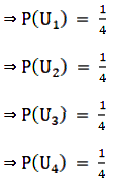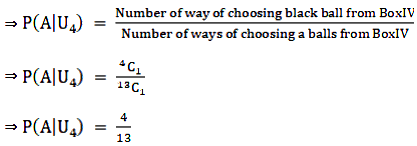Given:
Box I has 3 Black, 4 White, 5 Red, 6 Blue balls
Box II has 2 Black, 2 White, 2 Red, 2 Blue balls
Box III has 1 Black, 2 White, 3 Red, 1 Blue balls
Box IV has 4 Black, 3 White, 1 Red, 5 Blue balls
Let us assume U1, U2, U3, U4 and A be the events as follows:
U1 = choosing Box I
U2 = choosing Box II
U3 = choosing Box III
U4 = choosing Box IV
A = choosing Black ball from box We know that each urn is most likely to choose. So, probability of choosing a urn will be same for every Urn

The Probability of choosing balls from each box differs from box to box and the probabilities are as follows:
⇒ P(A|U1) = P(Choosing black ball from Box I)

⇒ P(A|U3) = P(Choosing black ball from Box III)

Now we find
P(U3|A) = P(The black ball is from Ball III)
Using Baye’s theorem:

∴ The required probability is \(\cfrac{156}{947}.\)